| The Pagans | |
|---|---|
| Directed by | Ferruccio Cerio |
| Cinematography | Tonino Delli Colli |
| Music by | Franco Ferrara |
| Distributed by | Variety Distribution |
The Pagans (original title: Il Sacco di Roma, USA re-issue title: The Barbarians) is a 1953 Italian film directed by Ferruccio Cerio. Based on the 1527 historical event, this film tells the story of the taking of Rome by the Spanish armies of Charles V.
In 1527 Rome was torn apart by the war between the Orsini fraction and that of the Colonna. Meanwhile, Spanish troops and lansquenets march to conquer the city.
Angela Orsini and Massimo Colonna, the two representatives of the noble families, love and marry in secret, but during the ceremony Angela's father bursts in and challenges Massimo to a duel. The latter juggles to avoid the clash, but a dagger thrown by a hitman of Tancredi Serra who demands the hand of Angela, kills the old Orsini. Massimo is forced to flee Rome, but returns there after the city is besieged, and before going to fight he makes a peace agreement with the Orsini to prove his innocence and love for Angela.
The city is taken and the last to resist take refuge in Castel Sant'Angelo. The leader of the resistance, Massimo, then manages to break the circle of the besiegers thanks to the help of a certain Fanfulla from Lodi, freeing the defenders.
Meanwhile, Angela learns from the assassin, now dying, the true version of the killing of her father: now nothing can prevent the marriage between her and Massimo.

The House of Colonna, also known as Sciarrillo or Sciarra, is an Italian noble family, forming part of the papal nobility. It was powerful in medieval and Renaissance Rome, supplying one Pope and many other church and political leaders. The family is notable for its bitter feud with the Orsini family over influence in Rome, until it was stopped by Papal Bull in 1511. In 1571, the heads of both families married nieces of Pope Sixtus V. Thereafter, historians recorded that "no peace had been concluded between the princes of Christendom, in which they had not been included by name".

The House of Orsini is an Italian noble family that was one of the most influential princely families in medieval Italy and Renaissance Rome. Members of the Orsini family include five popes: Stephen II (752-757), Paul I (757-767), Celestine III (1191–1198), Nicholas III (1277–1280), and Benedict XIII (1724–1730). In addition, the family included 34 cardinals, numerous condottieri, and other significant political and religious figures.

The Sack of Rome, then part of the Papal States, followed the capture of the city on 6 May 1527 by the mutinous troops of Charles V, Holy Roman Emperor during the War of the League of Cognac. Having lost their commander during the storm, the German, Spanish and Italian contingents of the Imperial army conquered the city of Rome and began looting, slaying and holding citizens for ransom in excess without any restraint. Pope Clement VII took refuge in Castel Sant'Angelo after the Swiss Guard were annihilated in a delaying rearguard action, where he remained until a ransom was paid to the pillagers. Benvenuto Cellini, eyewitness to the events, described the sack in his works. Only in February 1528 led the approach of the League forces under Odet de Foix to the army withdrawing towards Naples from the city. Rome's population had dropped from 55,000 to 10,000 due to the atrocities, famine, an outbreak of plague and fleeing the city. The subsequent loss of the League army during the Siege of Naples debilitated the League of Cognac, an alliance formed by France, Milan, Venice, Florence and the Papacy against Charles V.

Bracciano is a small town in the Italian region of Lazio, 30 kilometres northwest of Rome. The town is famous for its volcanic lake and for a particularly well-preserved medieval castle Castello Orsini-Odescalchi. The lake is widely used for sailing and is popular with tourists; the castle has hosted a number of events, especially weddings of actors and singers.
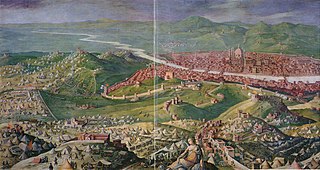
The War of the League of Cognac (1526–30) was fought between the Habsburg dominions of Charles V—primarily the Holy Roman Empire and Spain—and the League of Cognac, an alliance including the Kingdom of France, Pope Clement VII, the Republic of Venice, the Kingdom of England, the Duchy of Milan, and the Republic of Florence.
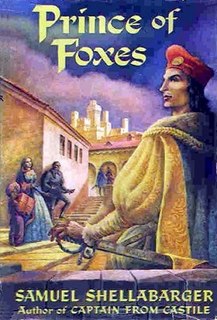
Prince of Foxes is a 1947 historical novel by Samuel Shellabarger, following the adventures of the fictional Andrea Orsini, a captain in the service of Cesare Borgia during his conquest of the Romagna.

Besieged is a 1998 film by Bernardo Bertolucci starring Thandiwe Newton and David Thewlis. The film is based on the short story "The Siege" by James Lasdun and was supposed to be a 60-minute teleplay until Bertolucci chose to expand it.

Marino is an Italian city and comune in Lazio, on the Alban Hills, Italy, 21 kilometres southeast of Rome, with a population of 37,684 and a territory of 26.10 square kilometres (10.08 sq mi). It is bounded by other communes, Castel Gandolfo, Albano Laziale, Rocca di Papa, Grottaferrata, and Ciampino. Marino is famous for its white wine, and for its Grape Festival, which has been celebrated since 1924.

The black nobility or black aristocracy are Roman aristocratic families who sided with the Papacy under Pope Pius IX after the Savoy family-led army of the Kingdom of Italy entered Rome on 20 September 1870, overthrew the Pope and the Papal States, and took over the Quirinal Palace, and any nobles subsequently ennobled by the Pope prior to the 1929 Lateran Treaty.

Pompeo Colonna was an Italian noble, condottiero, politician, and cardinal. At the culmination of his career he was Viceroy of the Kingdom of Naples (1530-1532) for the Emperor Charles V. Born in Rome, he was the son of Girolamo Colonna, whose father Antonio was second Prince of Salerno; and Vittoria Conti, of the Conti de Poli. His family belonged to the highest rank of nobility both of the City of Rome and of the Kingdom of Naples. Pompeo and his family were hereditary supporters of the Holy Roman Empire (Ghibbelines), and they spent their careers fighting their hereditary enemies, the Orsini family, and defending and expanding their family territories and interests. He played a significant, if sometimes disruptive, role in the Conclaves of 1521 and 1523 on behalf of the Imperial interest. His family commitments and his conclave activities brought Pompeo into conflict with the second Medici pope, Clement VII, whose election he vigorously opposed, and made him a leading figure in the attempted overthrow of Pope Clement and the Sack of Rome in 1527.
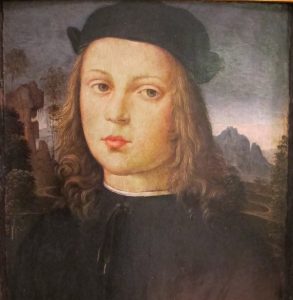
Alfonso of Aragon, Duke of Bisceglie and Prince of Salerno of the House of Trastámara, was the illegitimate son of Alfonso II King of Naples and his mistress Trogia Gazzela. His father, cousin of King Ferdinand II of Aragon, abdicated in favour of his legitimate son Ferdinand II of Naples.
Renzo da Ceri, true name Lorenzo dell'Anguillara was an Italian condottiero. He was a member of the Anguillara family.

Everso II degli Anguillara was an Italian condottiero, a member of the Anguillara family.
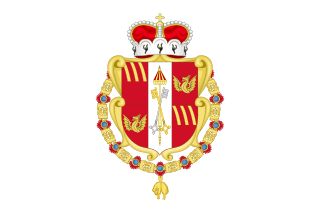
The Lordship of Piombino, and after 1594 the Principality of Piombino, was a small state on the Italian peninsula centred on the city of Piombino and including part of the island of Elba. It existed from 1399 to 1805, when it was merged into the Principality of Lucca and Piombino. In 1815 it was absorbed into the Grand Duchy of Tuscany.

The 1484 papal conclave elected Pope Innocent VIII after the death of Pope Sixtus IV.

Lorenzo Onofrio Colonna (1637–1689) was an Italian nobleman of the Colonna family. He was the 8th Duke and Prince of Paliano and hereditary Grand Constable of the Kingdom of Naples. He was also a Knight of the Golden Fleece.

Castello Orsini-Odescalchi is a castle in Bracciano, Lazio, Italy. It is located on the southern shore of Lake Bracciano. It was built in the 15th century, and combines the functions of a military defence structure and a civilian residence of the feudal lords of the period, the Orsini and Borgia, both papal families. As one of the largest and best-maintained castles in Italy, it also houses a museum; as a centre of cultural events, the Castello has hosted several high-profile weddings such as those of Tom Cruise/Katie Holmes, Eros Ramazzotti/Michelle Hunziker, and Petra Ecclestone/James Stunt.
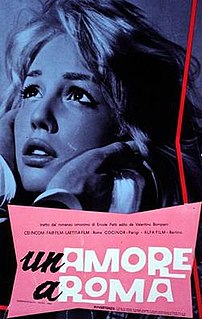
Un amore a Roma is a 1960 Italian romantic drama film directed by Dino Risi.
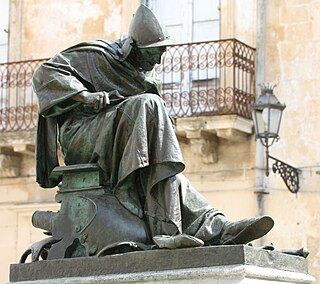
Bartolomeo Fanfulla's parents, Domenico Alon and Angela Folli, gave him multiple names: Giovanni or Giovanni Battista, Bartolomeo and Tito. Born in the province of Lodi, Fanfulla almost certainly died 24 February 1525 in the battle of Pavia. He had at least four children and nine grandchildren.
The Duchy of Bracciano was a fief of the Papal States, centred on lago di Bracciano and the town of Bracciano itself and ruled by a branch of the Orsini family with the title of Lord and Duke (1560–1696).